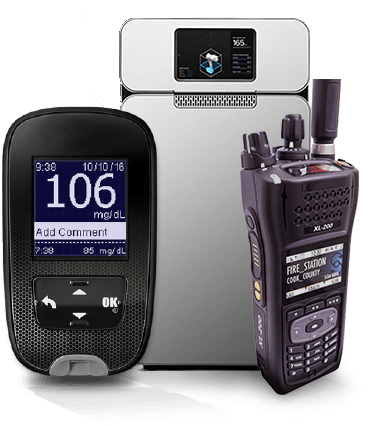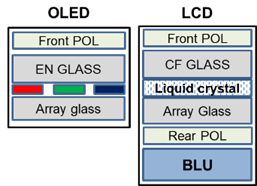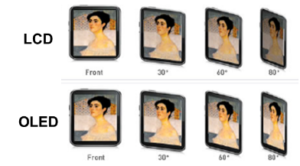
Technologies

OLED Displays
OLED (Organic Light Emitting Diode) display is made of self-emitting organic materials. It has superior contrast over TFT along with free form capabilities compared to rigid restrictions of other display technologies.
Our Strategies
- Material optimizing for a wide temperature range.
- External compensation algorithm for better performance under environmental dynamics
- Thin-film encapsulation (TFE) structures as barriers for flexible OLED.
- Continuous improvement to achieve higher efficiency and longer lifetime.
BOE Technology Highlights
- Flexible substrate
- Ultra-low temperature LTPS TFT backplane
- Thin
Types and Market Trends
| Criteria | Type | Market Demand |
| By Flexibility | Flexible: Curved/Bendable/Foldable | Increasing |
| Rigid | Decreasing |

How OLED works
Each sub-pixel of OLED displays utilizes organic polymers. When three different types of polymers are stimulated by a current, they emit photons (light) in red, green, and blue, respectively. This process is called electroluminescence (EL). This is the reason why OLED is also referred to as an EL display. The self-emitting mechanism of OLED delivers better overall optical performance, including ultra-wide viewing angles and high contrast without the need for a backlight unit (BLU).
Unlike liquid crystal displays, OLED displays are solid-state devices, which are usually made on one PI (polyimide) or glass substrate instead of two as for LCDs. Therefore, OLED display structures can be ultra-slim and flexible.
Applications
OLED has been increasingly popular in the consumer markets, especially for TVs, smartphones, VR displays, and wearable devices. The everchanging, vivid true-color image, displayed in high precision from a thin panel with narrow bezels, quite too often immerse the audience in the experience. Emitting light as a tiny sun, OLED lights also look as if they were natural, yet provide countless choices of colors to create a realistic atmosphere.
OLED has also entered the automotive market. To help form a modern, luxurious perception, automotive producers are actively adopting OLED for driver clusters, central infotainment, curved cockpit, rear/side-view mirrors, and lightings.
With outstanding optical performance and unlimited future potentials, OLED has been widely recognized as the premier choice compared to all other display technologies.
Editor: Charis Chen




